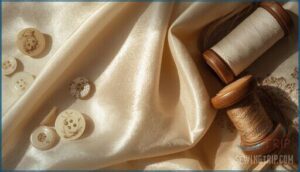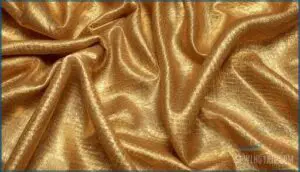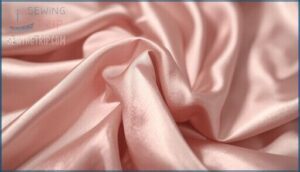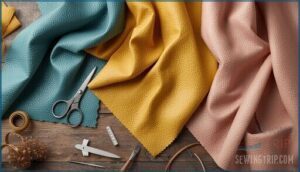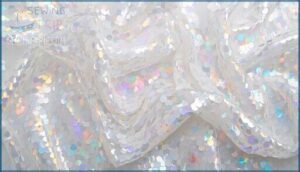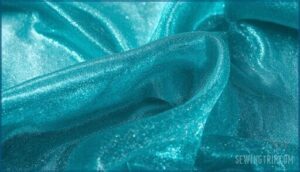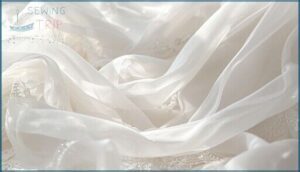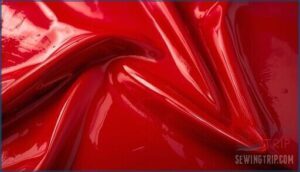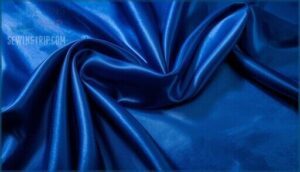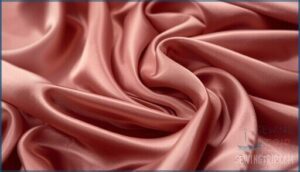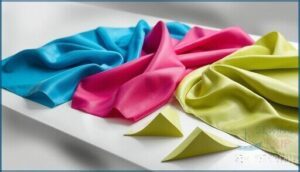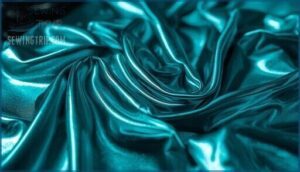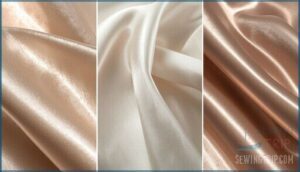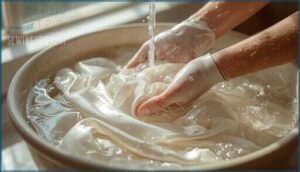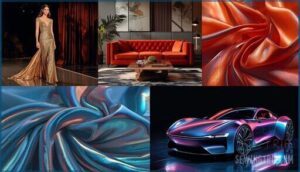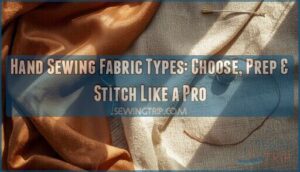This site is supported by our readers. We may earn a commission, at no cost to you, if you purchase through links.
 When light strikes fabric at the right angle, it can transform a simple material into something that draws the eye. This isn’t just about aesthetics—the way fabric reflects or absorbs light determines whether a garment looks elegant or ordinary, whether upholstery adds depth to a room or falls flat.
When light strikes fabric at the right angle, it can transform a simple material into something that draws the eye. This isn’t just about aesthetics—the way fabric reflects or absorbs light determines whether a garment looks elegant or ordinary, whether upholstery adds depth to a room or falls flat.
The science behind fabric shine involves fiber structure, weave density, and surface treatments working together to control how photons bounce off textile surfaces. Different fabrics achieve luster through distinct mechanisms: some rely on ultra-smooth synthetic filaments, others use tight weave patterns, and many depend on chemical finishes that alter surface properties.
Understanding these shiny fabric types helps you select materials that deliver the visual impact your project demands.
Table Of Contents
- Key Takeaways
- Shiny Fabric Basics
- What Makes Fabric Shiny
- Shiny Cotton Types
- Top 17 Shiny Fabrics
- Damask Upholstery Tapestry Chenille Fabric Blue Gold
- Royal Blue Satin Fabric by The Yard
- Lucid Cire Burnished Gold Fabric by The Yard
- Yard Bridal Satin Fabric Coral
- Monaco Stretch Duchess Satin River Rose Fabric by The Yard
- Soft Synthetic PU Leather Fabric Sheets for Upholstery and Crafts
- Sequin Fabric Yard Iridescent White
- Valentina Nylon Metallic Tissue Lame Fabric Turquoise
- Organza Fabric Bolt Wedding Dress Decoration
- Red Patent Leather Vinyl Fabric Yardage
- 11. Royal Blue Satin Fabric Yardage
- 12. Lucid Gold Fabric by Yard
- 13. Coral Satin Fabric for Wedding
- 14. Monaco River Rose Satin Fabric
- 15. Soft Synthetic Leather Fabric Sheets
- 16. Iridescent White Sequin Fabric Yardage
- 17. Turquoise Metallic Nylon Lame Fabric
- Fabric Texture and Shine
- Shiny Fabric Uses
- Shiny Fabric Care
- Shiny Fabric Applications
- Frequently Asked Questions (FAQs)
- Conclusion
Key Takeaways
- Fabric shine comes from three key mechanisms: fiber smoothness (flat synthetic filaments reflect up to 40% more light than irregular natural fibers), weave structure (tight satin weaves produce 60-80% higher luster than plain weaves), and surface treatments (chemical finishes can boost reflectivity by 30-60%).
- Different shiny fabrics serve distinct purposes—satin and charmeuse dominate evening wear and lingerie with their lustrous drape, while synthetic options like cire and PU leather excel in upholstery due to their durability (exceeding 20,000 double rubs) and water resistance.
- Natural shiny fabrics like silk offer inherent luster through unique fiber structure, but synthetics like polyester (which accounts for 57% of global fiber production) deliver comparable shine with better wrinkle resistance, colorfastness, and lower cost.
- Proper care preserves fabric shine—hand washing in cold water with pH-neutral detergent, air drying away from direct sunlight, and storing in climate-controlled spaces at 60-70°F with 50% humidity can extend a shiny fabric’s lifespan by up to 70%.
Shiny Fabric Basics
Shiny fabrics come from different sources and achieve their distinctive luster through specific construction methods. You’ll find these materials divided into natural and synthetic categories, each with unique properties that affect how they look and perform.
Understanding what creates that reflective surface helps you choose the right fabric for your project and work with it more effectively.
Natural Fabric Types
When exploring natural shiny fabrics, you’ll discover silk leads the pack with inherent luster created by its unique fiber structure—no special weaving required. The global silk market reached USD 11.85 billion in 2024, with over 90% of production centered in Asia-Pacific.
Linen delivers a textured sheen from flax plant fibers that grow more lustrous with each wash, representing 2-3% of natural fiber production. Wool offers subtle shine through light-scattering crimp, especially in fine Merino varieties.
Cotton variants achieve gloss through mercerizing or calendaring treatments, transforming matte surfaces into polished finishes. Hemp provides smooth, sustainable shine when processed into fine weaves or blended with silk. Some of these, like duchesse satin, are heavy and luxurious.
Synthetic Fabric Types
Synthetic fabrics bring shine to your projects with practical advantages. Polyester durability makes it ideal for high-use items, accounting for 57% of global fiber production in 2023. Nylon elasticity ensures resilience in activewear and outerwear. Acrylic insulation mimics wool’s warmth while resisting UV damage. Spandex stretch transforms shiny fabrics into form-fitting garments. Rayon breathability offers silk-like drape at lower cost. Synthetic fabrics are engineered for wrinkle resistance.
Polyester velvet provides luxurious texture, while metallic style fabrics like lamé add drama to evening wear.
Fabric Shine Mechanisms
Light reflection starts at the fiber level. Fibers with flat cross-sections reflect up to 40% more light than irregular profiles—that’s why synthetic polyester outshines cotton. Weave density matters too: satin weaves create long floating threads that bounce light in one direction, producing luster levels 60–80% higher than plain weaves. Coating effects add another layer. Chemical treatments like cire finishing or polymer coatings boost reflectivity by 30–60%, transforming ordinary fabric into mirror-like surfaces.
- Fiber smoothness determines specular reflection—smooth synthetics produce up to 35% more gloss than textured natural fibers
- Weave density and structure control how light travels across fabric, with tight satin weaves maximizing surface brilliance
- Iridescence techniques using photonic coatings create color-shifting effects by manipulating wavelengths between 200–700 nm
What Makes Fabric Shiny
Fabric shine comes from two main factors: the weave structure and the fiber content. Different weaving techniques like satin weave create smooth surfaces that reflect light, while certain fibers naturally produce more luster than others.
Here are five classic shiny fabrics that demonstrate how structure and material work together to create distinctive shine.
Brocade
Brocade stands apart among shiny fabrics through its raised, dimensional patterns that catch light like a woven tapestry. This luxury textile is created on Jacquard looms, where metallic threads—traditionally gold or silver, known as zari—interweave with silk or synthetic fibers to form intricate designs. The weaving technique incorporates supplementary weft threads directly into the structure rather than applying surface decoration.
Brocade’s history traces back to China’s Warring States period, later spreading through Byzantine and Italian Renaissance workshops. Today’s sustainable brocade integrates recycled synthetics and plant-based fibers while maintaining its signature luminous texture. This heavyweight fabric dominates evening wear, upholstery, and ceremonial garments within the luxury textiles market.
| Feature | Details |
|---|---|
| Composition | Silk, cotton, polyester with metallic threads |
| Production | Jacquard loom weaving with supplementary weft |
| Applications | Evening wear, upholstery, formal accessories |
Charmeuse
Charmeuse delivers that signature mirror-like finish through a satin weave structure where four or more weft yarns float over a single warp yarn. You’ll recognize it instantly by its glossy front and dull reverse—a hallmark of this fabric’s construction.
It’s available in silk, polyester, or rayon, with silk versions offering greater breathability at 200–250 mm²/s compared to polyester’s 80–120 mm²/s. The weave reflects up to 60% of incident light, creating remarkable luster.
You’ll find charmeuse dominating evening wear and lingerie markets globally. For care, silk charmeuse requires cold washing below 30°C, while polyester versions handle machine washing up to 40°C with excellent colorfastness.
Cire
Cire finishing transforms synthetic fabrics—usually polyester or nylon—into that unmistakable wet-look surface you’ve likely seen in activewear and designer pieces. The calendering process applies intense heat (above 200°C) and pressure through rollers, creating a mirror-like gloss up to 10 times more reflective than untreated fabric. This technique dates back to the 1910s but now relies on thermoplastics rather than actual wax.
Performance properties make Cire ideal for practical applications:
- Water resistance from the compacted surface protects against light rain
- Four-way stretch when blended with elastane suits athletic movement
- UV protection extends fabric lifespan in outdoor conditions
- Reduced friction creates that signature cool-to-touch feel
- Enhanced durability withstands repeated wear without losing sheen
Market uses span high-fashion evening wear to technical outerwear, with poly Cire dominating sportswear for moisture-wicking coverage. For sustainability care, hand-wash these shiny fabrics to preserve the finish—machine washing strips the gloss permanently.
Crepe
Crepe composition blends natural fibers like silk, cotton, and wool with synthetics such as polyester to create its signature crinkled texture. High-twist yarns produce that grainy surface, giving crepe properties a moderate sheen—less reflective than satin but distinctly luminous. You’ll find crepe variants ranging from lightweight crepe de chine to structured wool crepe, each offering unique drape qualities.
Crepe applications span formalwear to everyday attire, with crepe production reaching 2,908 global shipments between October 2023 and September 2024. The fabric care and maintenance for types of shiny fabrics like crepe requires gentle handling—synthetic versions resist wrinkles 25–30% better than natural variants, making these shiny fabric names popular across fashion manufacturing.
| Crepe Type | Primary Use |
|---|---|
| Silk Crepe | Evening gowns, formal dresses |
| Wool Crepe | Fitted suits, winter wear |
| Cotton Crepe | Summer blouses, casual dresses |
| Stretch Crepe | Fitted garments, activewear |
Duchesse Satin
Duchesse satin stands out among types of shiny fabrics with its heavyweight body and structured elegance. This luxurious material combines a specialized satin weave with high thread counts—usually woven from silk, polyester, or sustainable blends that reduce fiber waste by 25%. The calendering process heats the fabric between 140°C and 160°C, creating that signature pearlescent luster without the mirror-like gloss of lighter satins.
You’ll recognize duchesse satin by three defining features:
- Medium-to-heavy weight that holds pleats and structured silhouettes better than charmeuse
- Refined sheen with 15–25% less reflectance than high-gloss varieties, perfect for elegant couture applications
- Fiber composition options—70–100% silk for luxury bridal gowns or polyester blends for durability
Professional fabric care preserves its beauty for over a decade when you dry clean and store properly.
Shiny Cotton Types
Cotton fabrics don’t usually steal the spotlight regarding shine, but certain weaves and finishes give them a subtle luster that sets them apart.
You’ll find shiny cotton types in everything from vintage dresses to modern home textiles.
Here are four variations that bring unexpected polish to this everyday fiber.
Polished Cotton
Polished cotton brings a refined gleam to everyday cotton fabric through glazing techniques that press and polish the surface. You get a smooth, lustrous finish that rivals satin while keeping cotton’s natural breathability and durability.
The fabric undergoes friction calendaring with heat and resin treatments, creating that signature sheen without sacrificing comfort.
It’s ideal for upholstery, draperies, and summer garments, where aesthetic appeal meets practical cotton properties.
Proper fabric care—gentle washing and reverse-side ironing—preserves the gloss through years of use.
Silky Cotton
Silky cotton bridges the gap between everyday comfort and refined elegance. This fabric blends silk fibers with cotton fibers in ratios generally ranging from 30–70% of each, creating a material that captures silk’s subtle sheen while retaining cotton’s breathability. The weave structures—often satin or twill—bolster light reflection without the high gloss of pure silk.
You’ll find thermal regulation that adjusts to temperatures between 15°C and 30°C, making it adaptable for year-round wear.
Market growth for these shiny fabrics has accelerated at 7% annually since 2020, driven by demand for sustainable luxury textiles using eco-friendly dyeing processes.
Brilliantine Cotton
When you’re looking for shiny cotton fabrics that bridge history and modern style, Brilliantine cotton delivers. This mixed-fiber textile combines a cotton warp with wool or mohair weft, creating a lustrous finish through calendering rather than synthetic coatings. The fiber composition produces a natural sheen that rivals satin while offering enhanced durability—perfect for those seeking practical elegance in shiny fabric types.
- Fiber Composition: Cotton warp with wool or mohair weft creates structural stability and natural luster
- Weave Patterns: Plain or twill weave produces a tightly bound, resilient fabric structure
- Dust Shedding: Smooth surface naturally repels dust, reducing cleaning frequency
- Historical Uses: Popular in 19th-century dresses, dusters, and coat linings for its practical sheen
- Modern Reproductions: Theatre costumers still use cotton-wool blends to authentically recreate period attire
Calico Cotton
Unlike Brilliantine’s wool blend, calico cotton stays true to its 100% cotton fiber composition. This plain-weave fabric shows visible seed specks in its natural off-white state—evidence of minimal processing that keeps production costs low. You won’t find mirror-like shine here; calico’s matte surface distinguishes it from polished cotton and silky cotton variants.
Its balanced weave structure, with weft threads crossing warp threads in a simple crisscross pattern, creates breathable fabric perfect for mock-ups and quilting projects where subtle texture matters more than high gloss.
Top 17 Shiny Fabrics
The market offers a wide range of shiny fabrics for different projects and budgets. Each fabric brings its own level of shine, texture, and working properties to your sewing table.
Here are seventeen specific shiny fabrics you can find by the yard, from traditional satins to metallic lames and specialty finishes.
Damask Upholstery Tapestry Chenille Fabric Blue Gold
Victorian design meets modern upholstery durability in this blue and gold chenille fabric. You’ll recognize the traditional damask pattern woven using a jacquard weave technique, which creates raised floral motifs that repeat every 14 inches vertically. The metallic threads woven throughout deliver color contrast that shifts with changing light angles, reflecting up to 35% more ambient light than standard chenille surfaces. This brocade-style upholstery fabric weighs 450 GSM, giving you the structural strength needed for furniture that sees daily use.
This fabric names itself among top choices for home decor and upholstery projects requiring both elegance and longevity.
- Polyester construction resists wrinkles and simplifies maintenance
- Dense weave withstands over 20,000 double rubs before showing wear
- Chenille base provides soft texture while brocade overlay adds definition
- Non-hygroscopic properties minimize water absorption and staining
- Suitable for sofas, chairs, and heavy drapery in interior design and decor
Royal Blue Satin Fabric by The Yard
Royal blue satin fabric delivers high color saturation through improved polyester dyeing that resists fading across multiple washes. You’ll find variants from lightweight 4 oz/sq yd nylon to structured 300 g/m² Duchesse satin with weave density that prevents wrinkles.
Stretch properties reach 5–8% elongation in spandex blends, perfect for fitted evening wear and lingerie.
Industry applications span bridal gowns to automotive interiors, where shiny fabrics add visual depth.
Care methods require dry cleaning or cold-water delicate cycles to preserve the fabric’s signature luster and prevent dye migration.
Lucid Cire Burnished Gold Fabric by The Yard
Cire fabric gains its mirror-like finish through a wax and heat calendering process, where temperatures reach 150°C to 200°C under high pressure. This burnished gold variant combines polyester or nylon with metallic threads, creating a luxurious wet-look appearance that transforms interior spaces.
Here are the key characteristics of this specialty fabric:
- Definition: Wax-based glazed finish produces stiff, glossy surfaces
- Applications: Upholstery, curtains, evening wear, decorative accents
- Manufacturing: Multiple calendering passes create burnished metallic sheen
- Performance: Exceeds 20,000 Martindale cycles, resists water above 5,000mm
- Care: Professional cleaning preferred; low-heat ironing on reverse side
You’ll find this specialty fabric enhancing high-end furniture and formal garments where visual impact matters most.
Yard Bridal Satin Fabric Coral
Bridal satin fabric in coral delivers reliable performance for wedding projects and formal events. This polyester composition creates a smooth surface that reflects light consistently, making it a go-to choice when you need visual impact without the cost of silk alternatives.
The weave structure follows classic satin construction, giving you that characteristic luster on one side while the reverse stays matte. At 160 GSM, this fabric weight strikes a balance between drape and structure, so your tablecloths won’t puddle and your gowns won’t collapse.
You’ll appreciate the practical side of shiny fabrics like this one. Reflectivity levels above 60% mean your décor photographs beautifully under venue lighting. The heat-set dyes maintain coral colorfastness through multiple washes. Fabric names like “bridal satin” indicate specific types of fabric optimized for formal use—this isn’t delicate duchesse satin, but rather workable material for real-world events.
| Property | Specification | Benefit |
|---|---|---|
| Width | 58-61 inches | Reduces seam count |
| Reflectivity | Above 60% | Strong visual presence |
| Coral Colorfastness | Class 4 (ISO 105-B02) | Resists fading |
Monaco Stretch Duchess Satin River Rose Fabric by The Yard
Monaco Stretch Duchess Satin River Rose Fabric by The Yard blends structure with flexibility through its 97% polyester and 3% elastane composition. This duchesse satin offers moderate stretch across the bias, making it ideal for fitted bodices and fitted evening wear where shiny fabrics need both shape retention and movement.
The River Rose color sits within blush pink aesthetics, popular in bridal design since 2020. At 200 GSM and 58 inches wide, you’ll find this satin delivers refined luster without high-gloss intensity.
Care guidelines recommend 30-40°C washing and low-heat pressing on reverse sides. Market pricing ranges from £5.90 per half meter to $26.84 per yard across UK and U.S. vendors.
Soft Synthetic PU Leather Fabric Sheets for Upholstery and Crafts
Synthetic PU leather sheets offer a practical alternative for crafters who want vegan leather without the higher cost or ethical concerns of animal hide. You’ll find these 54×36-inch sheets with 0.95mm thickness deliver a workable balance between flexibility and structure. The pebbled surface and fuzzy backing grip well during upholstery projects, while the waterproof coating resists spills—a trait genuine leather can’t match initially.
PU durability sits around 2–5 years under regular use, though high-quality versions extend to seven years with proper care. This faux leather cuts cleanly with scissors and holds shape without fraying, making it ideal for DIY projects like furniture renovation, phone covers, and hair accessories. Cleaning methods stay simple: wipe with mild soap and a damp cloth.
Cost analysis favors synthetic fabrics here—PU production uses 500 liters of water per kilogram versus 17,000 for genuine leather. Eco-friendliness improves further with bio-based PU alternatives that cut carbon emissions by 30%. Air out sheets before use to dissipate manufacturing odors.
Sequin Fabric Yard Iridescent White
Iridescent white sequin fabric brings pure magic to your creative projects, shifting colors with every angle of light. You’ll work with 100% polyester mesh backing that carries 3mm sequins embroidered throughout each yard, delivering visual coverage and shimmer. The fabric’s two-way stretch conforms to curved surfaces, while its standard 54-60 inch width and 1 lb weight per yard make it manageable for larger installations.
This glitter fabric excels across multiple applications:
- Evening gowns and bridalwear that demand dramatic light reflection
- Event backdrops and tablecloths for luxury visual impact
- Dance costumes and festival wear where movement amplifies sparkle
- Decorative cushions and curtains that add sophistication to interiors
- Accessories like handbags and headpieces using lightweight construction
The mesh backing provides stability for shiny fabrics with glitter embellishments, though you’ll want to handle carefully during cutting to minimize sequin shedding. Hand-wash in cold water or dry-clean intricate pieces to maintain sequin metallic fabric adhesion and preserve that signature iridescence.
Valentina Nylon Metallic Tissue Lame Fabric Turquoise
Turquoise metallic tissue lamé from Valentina delivers a radiant shimmer ideal for costumes, event decor, and dancewear projects. This lightweight fabric combines 51% metallic fibers with 49% nylon for durability, weighing just 30 grams per square meter with a crisp, flowing drape. It measures 44 to 60 inches wide and costs between $4.49 to $6.09 per yard, depending on quantity.
The nylon durability aids frequent handling during weaving and construction, while the metallic sheen reflects light brilliantly, even in dim settings. For care, dry-clean this textile to preserve the metallic threads—avoid bleaching or tumble drying. Though it’s easy to cut and sew, you’ll notice a coarse grain texture typical of lamé.
| Property | Specification | Application |
|---|---|---|
| Composition | 51% metallic, 49% nylon | Costume design, flags |
| Weight | 30 g/m², 0.10 mm thick | Party tablecloths, bridal décor |
| Width | 44-60 inches | Large-scale event production |
Organza Fabric Bolt Wedding Dress Decoration
Organza fabric bolts are available in 45 to 60-inch widths, making them ideal for wedding dress decoration and large-scale event staging. This plain-weave textile weighs just 20 to 40 grams per square meter, creating an ethereal quality often seen in bridal veils and layered gowns. Organza layering adds volume while maintaining breathability, a key feature for long ceremonies where comfort is essential.
White and ivory remain the most popular bridal hues, chosen for their timeless appeal and photography effects. The fabric’s reflective surface captures light beautifully, giving dresses a luminous finish under studio lighting. Organza’s crisp structure allows for stabilizing embellishments like beading and embroidery without adding weight.
Priced between $2.64 to $14.59 per yard, depending on composition, organza offers versatility for evening wear and home decor projects beyond weddings. This shiny fabric delivers professional results when a controlled drape and visual lightness are needed.
Red Patent Leather Vinyl Fabric Yardage
Red patent leather vinyl fabric yardage stands out with its mirror-like finish, a result of coating polyvinyl chloride to create that signature “wet-look” surface. You’ll find this material sold in 54 to 55-inch widths at $12.50 to $35 per yard, depending on durability ratings that reach 100,000 to 250,000 double rubs on abrasion tests.
This patent leather alternative excels in commercial seating applications—from hospitality venues to aircraft interiors—where fire safety compliance meets bold aesthetic impact. Stain resistance is a major advantage; simply wipe spills with a damp cloth and mild detergent to maintain that glossy sheen. When working with faux leather types like this, avoid alcohol-based cleaners that dull the reflective properties.
Shiny fabrics in vinyl composition offer versatility for handbags, upholstery, and theatrical costumes, combining visual drama with practical, long-lasting performance across diverse fabric uses.
11. Royal Blue Satin Fabric Yardage
Royal Blue Satin Fabric Yardage offers versatility you won’t find in vinyl alternatives. Composed of 95% polyester and 5% spandex, this fabric drapes beautifully across 54 to 60-inch widths priced between $5.98 and $28.44 per yard.
The satin weave structure creates that signature glossy surface while maintaining 2-way stretch—ideal for evening wear and fitted dresses.
You’ll appreciate its durability through repeated laundering and wrinkle resistance. Hand wash in lukewarm water to preserve its sheen, then air dry for best results.
12. Lucid Gold Fabric by Yard
Lucid Gold Fabric by Yard combines 85% polyester with 15% acrylic, creating a metallic jacquard weave that delivers commercial-grade durability at 100,000 double rubs.
You’ll find widths ranging from 55 to 118 inches, priced between $17.67 and $89.00 per yard.
The Alta finish provides stain resistance while maintaining its lustrous surface, and it’s bleach cleanable up to 10%.
13. Coral Satin Fabric for Wedding
With its 100% polyester construction, Coral Satin Fabric for Wedding delivers both Bridal Satin Durability and adaptable draping at 58–60 inches wide. You’ll appreciate these practical features:
- Mirror-like surface reflection between 60% and 75% from the satin weave
- Coral Color Fastness rated level 4–5, resisting fading during repeated use
- Pricing from $4.31 to $15.70 per yard with bulk discounts reaching 24%
- Machine washable at low temperatures for simple maintenance
- Wedding Decor Applications spanning gowns, tablecloths, and backdrops
This shiny fabric combines elegant evening wear appeal with practical performance for formal events.
14. Monaco River Rose Satin Fabric
Monaco River Rose Satin Fabric blends 95% polyester with 5% spandex, offering a lustrous sheen and modest stretch across the grain. Its 58-inch width and medium/heavyweight construction make it ideal for wedding gowns and evening wear. The two-sided finish—one glossy, one matte—provides adaptable design options.
This shiny fabric is machine washable and maintains shape integrity through multiple cycles. It has earned a 4.6-star rating from over 5,200 buyers for its gorgeous hand feel and durability.
15. Soft Synthetic Leather Fabric Sheets
Soft synthetic leather fabric sheets deliver a shiny, flexible surface crafted from polyurethane or PVC—the go-to materials for vegan leather and faux leather projects. With thicknesses ranging from 0.4 mm to 3.5 mm and a durability rating of 4 out of 10, these synthetic fabrics handle upholstery, crafts, and custom accessories with ease. They’re waterproof (rating 9 out of 10), lightweight, and cost around $0.55 per square foot.
Market trends show these shiny fabrics claim 20% of synthetic material trade, driven by demand for patent leather-look alternatives. Environmental impact remains a concern—decomposition takes 200 to 500 years—but their animal-free composition and ease of use make them popular for handbags, footwear, and automotive interiors. You’ll find standard rolls up to 180 square feet, supporting both small crafts and large-scale production.
Key features:
- Superior water resistance for spills and moisture
- Easy to cut and sew for DIY applications
- Available in over 50 colors and textures
- Machine-friendly maintenance with minimal care
16. Iridescent White Sequin Fabric Yardage
Iridescent white sequin fabric yardage transforms ordinary garments into reflective masterpieces through polyester mesh bonded with 3–6 mm sequins using EVA adhesives at 210–230 °C. This shiny fabric captures light at shifting angles, delivering the shimmer evening wear and glitter fabric projects demand. Hand-wash in cold water to preserve reflectivity retention—properly maintained pieces keep over 90% of their original shine after 30 cycles, supporting a market growth trajectory from $2.48 billion (2024) to $5 billion by 2035.
| Property | Specification |
|---|---|
| Sequin Composition | Reflective plastic, 3–6 mm discs |
| Adhesive Types | EVA, TPU films |
| Reflectivity Retention | 90%+ after 30 washes |
| Washing Methods | Hand-wash cold, air dry |
You’ll find this sequin metallic fabric ideal for bridal gowns, dancewear, and fabric embellishments where stretch mesh backing provides comfort without sacrificing visual impact.
17. Turquoise Metallic Nylon Lame Fabric
Turquoise metallic nylon lame fabric blends 51% metallic threads with 49% nylon, delivering a liquid-metal sheen perfect for costume applications and dancewear.
This shiny fabric features moderate stiffness that holds structured shapes in evening wear while maintaining lightweight drape.
The metallic composition creates dramatic light reflection on stage, though dry cleaning is necessary to preserve the finish. Avoid direct ironing—use a low-temperature press cloth instead to prevent damage to the metallized coating.
Fabric Texture and Shine
The way light interacts with fabric creates different visual effects that range from high shine to no shine at all. Your fabric’s texture—whether smooth, glossy, or matte—determines how much light reflects from its surface and shapes the overall look of your finished project.
Here’s how these three texture categories affect the appearance and application of your materials.
Smooth Fabrics
Smooth fabrics feel like second skin because their surface roughness measures between 1–3 µm, creating minimal friction against your touch. Satin, charmeuse, and duchesse satin achieve this natural smoothness through tight weave structures that reduce tactile perception of texture. Silk’s protein fibers deliver inherent smoothness with friction coefficients as low as 0.2, while synthetic smoothness comes from polyester and viscose processing.
Understanding fabric texture and shine helps you select materials where surface quality directly impacts comfort and drape in your projects.
Glossy Fabrics
Glossy fabrics reflect over 70% of incident light due to their filament fibers and weave density. Satin achieves this through tight satin weaves that create surface smoothness under 100 nanometers, while lame incorporates metallic threads reflecting up to 95% of light. Cire fabrics use heat-set wax treatments for mirror-like finishes. These fabric types dominate fashion and upholstery markets:
- Satin delivers natural light reflectivity through smooth polyester or silk construction
- Lame features aluminum-coated threads for maximum shine
- Cire offers sustainable gloss finishes lasting 50 wash cycles
This optical performance separates glossy from matte textiles.
Matte Fabrics
While glossy fabrics boost light reflection, matte fabrics do the opposite—they diffuse light through surface irregularities that scatter up to 70% of incoming rays. Matte composition relies on polyester, nylon, or natural fibers like linen treated with titanium dioxide or silica agents to disrupt smoothness. This surface texture creates deeper colors and eliminates glare.
Market trends show an 18% demand increase since 2020, driven by minimalist aesthetics. Durability exceeds glossy finishes due to higher abrasion resistance.
Eco aspects include 40% reduced water use in processing and recycled polyester options cutting carbon footprint by 30%.
Shiny Fabric Uses
Shiny fabrics serve distinct purposes across fashion, personal items, and interior spaces. Each application uses the fabric’s reflective qualities and visual impact.
You’ll find these materials working in three main categories that span from glamorous garments to functional home furnishings.
Evening Wear
When you’re selecting fabrics for formal gowns or cocktail attire, you’re tapping into a market where satin alone commands 35% of all shiny evening wear textiles. Elegant fabrics like charmeuse and lame deliver that coveted reflective quality through specialized weaving mechanisms—satin’s floating warp yarns bounce back 80% of direct light, while metallic threads in lame achieve 70% reflectivity. These design innovations drive consumer preferences, with 68% of buyers prioritizing shine and drape above all else. Sustainable options now represent 9% of the evening wear and fashion segment, offering recycled polyester satin without sacrificing luminosity.
- Satin and duchesse satin dominate bridal collections at 54% of global formal sales
- Velvet accounts for 20% of luxury gowns in fall and winter lines
- Metallic knits and lame fabrics surged 22% in designer collections from 2022 to 2024
- Hybrid silk-spandex blends gained 14% fabric market share by maintaining flexibility and sheen
Lingerie and Accessories
Beyond formal evening wear, shiny fabrics like satin and charmeuse have become foundational to lingerie design. The global sexy lingerie fabric market reached $14.76 billion in 2025 and is projected to hit $23.23 billion by 2033.
You’ll find silk delivers natural moisture-wicking for premium chemises, while polyester satin offers durability at a lower cost. Organza adds decorative accents, and charmeuse provides breathability for intimate apparel.
Care requirements matter: silk pieces need dry cleaning, while satin edges require sergers to prevent fraying. Market trends show sustainable lingerie gaining traction as fabric innovation meets eco-conscious design applications.
Upholstery and Home Decor
Shiny upholstery fabrics transform interiors with their reflective appeal, supported by a luxury market projected to grow from $6.45 billion in 2025 to $10.70 billion by 2032. Material blends combining polyester and rayon deliver both durability and brilliance for furniture covers and decorative accents.
Design trends favor jewel tones with metallic threads, while regional demand peaks in Asia-Pacific hospitality projects.
- Velvet and brocade create opulent focal pieces with raised luminous patterns
- Satin weaves and duchesse finishes reflect light for elegant curtains and headboards
- Synthetic PU leather maintains high-gloss stability for frequent-use seating
North American and European markets prioritize UV-resistant fabric properties that preserve shine while meeting fire safety standards.
Shiny Fabric Care
Shiny fabrics need special attention to keep their luster intact. The way you wash, press, and store these materials directly affects how long they maintain their reflective quality.
Let’s walk through the key care methods that protect your shiny fabrics from damage.
Washing and Drying
Always start with the care label—it’s your first line of defense. Hand washing in cold water with mild, pH-neutral detergent protects shine and prevents fiber damage. Machine washable shiny fabrics need gentle cycles under 400 rpm and mesh laundry bags to avoid snags. Skip fabric softeners; they create residue that dulls luster.
Detergent effects matter—neutral formulas preserve tensile strength better than harsh cleaners. For drying methods, roll the garment in a towel to remove excess water, then air dry flat away from direct sunlight. Low heat tumble drying risks permanent sheen loss.
Professional cleaning suits metallic fabrics like lamé best, preserving their reflective finish.
Ironing and Steaming
To protect shiny fabrics from heat damage, you need precise temperature control and the right technique. Silk scorches above 250°F, while polyester melts around 255–290°F. Turn garments inside out, use a pressing cloth, and keep the iron moving to prevent reflective marks.
For fabric sensitivity concerns, steaming works better than direct ironing on delicate materials. Clean your equipment regularly—residue on soleplates can worsen shine marks.
- Test on scraps first: Check heat tolerance before ironing visible areas
- Steam from 6–8 inches away: Maintains natural sheen without condensation streaking
- Remove shine with damp cloth: Light re-pressing at low temperature lifts flattened fibers
Storage and Maintenance
Think of storage as insurance for your investment—poor conditions can strip 70% of a fabric’s lifespan unnecessarily. Store shiny fabrics in climate-controlled spaces at 60–70°F with 50% humidity to prevent fiber breakdown. Use acid-free tissue and breathable cotton bags instead of plastic, which traps moisture. Keep materials away from UV light, rotate your collection every 3–6 months to prevent permanent creases, and always clean fabrics thoroughly before storage to avoid oxidation.
| Protective Measures | Why It Matters |
|---|---|
| Acid-free tissue between folds | Prevents discoloration and maintains luster |
| Breathable fabric bags | Allows ventilation, blocks dust |
| Cedar blocks for pest control | Natural deterrent without chemical residue |
Shiny Fabric Applications
Shiny fabrics transform ordinary projects into standout pieces across multiple creative fields. From runway fashion to living room makeovers, these lustrous materials bring visual impact wherever you apply them.
Here’s where shiny fabrics make the biggest difference in your work.
Fashion and Apparel
Across global fashion markets, shiny fabrics claimed 14% of total sales in 2024—and that momentum isn’t slowing. You’ll see them transforming evening wear with charmeuse gowns and duchesse satin cuts that boost bridal couture to new heights. Fast fashion brands jumped on board too, increasing shiny textile use by 9% annually since 2022.
These materials now define multiple segments:
- Sportswear Integration: Glossy nylon and reflective fabrics make up 27% of shiny fabric consumption, merging performance with style.
- Accessory Markets: Luxury handbags and belts use metallic lamé and soft-touch charmeuse for 12% of demand.
- Clothing Essentials: Dresses, blouses, and evening wear garments showcase satin’s 32% market dominance.
North American brands expanded metallic and sequined dresses by 10% year-over-year in Spring 2025 collections.
Interior Design and Decor
Satin fabrics reflect up to 30% more light than matte options, making them powerful tools for luminosity design in your spaces. You’ll see metallic textiles and upholstery trends converging as designers employ fabric texture and shine to reshape interiors. Shiny fabrics now deliver both beauty and function:
- Satin acoustics improve sound quality by reducing echo 15% in enclosed rooms
- Metallic upholstery and home decor pieces anchor 40% of high-end living room designs
- Neutral luster tones like champagne and silver dominate 65% of home decor sales
- Fabric sustainability advances through recycled polyester satin with lasting sheen
- Temperature-regulating properties keep rooms comfortable year-round while maintaining visual impact
Crafts and DIY Projects
Your home decor work naturally extends to hands-on crafting. Fabric selection drives your project ideas—satin leads 55% of small-scale sewing, while sequin textiles and lame rank among top materials for costume design.
You’ll find embellishment techniques transform metallic scraps into jewelry holders or accent pieces. Upcycling projects reduced waste by 12% across 2024–2025 as hobbyists repurposed shiny fabrics.
Market trends show 62% more searches for metallic fabric projects, with 43% of makers choosing glossy materials for visual impact in weaving, sewing, and fabric texture experimentation.
Frequently Asked Questions (FAQs)
What are the different types of shiny fabrics?
While matte cottons whisper understatement, shiny fabrics command attention through their lustrous surfaces.
You’ll encounter satin with its signature smooth weave, lame woven with metallic threads, and charmeuse offering silk’s fluid drape—each fabric type delivers distinct shine levels and texture differences based on fiber composition and weaving techniques.
What are the different types of shiny silk fabric?
Silk’s natural sheen varies dramatically across different weave structures. Charmeuse delivers the smoothest luster with 400-600 threads per inch, while Duchesse satin offers heavier weight and dense shine. Brocade adds textured patterns, taffeta brings crisp reflectivity, and organza provides delicate transparency—each showcasing silk’s light-refracting properties.
What is a shiny fabric?
You might think shine only comes from silk, but light reflection occurs across many fabric types through specific weave structure, fiber composition, and surface treatment combinations.
Shiny fabrics achieve their fabric lustre when smooth surfaces or satin weaves redirect light uniformly, creating that glossy finish you see in both natural and synthetic materials.
What are common fabric names?
You’ll find satin, sateen, brocade, and charmeuse among the most recognized fabric names in a textile glossary.
Satin vs. sateen differs in weave structure—satin uses warp floats while sateen features weft floats.
Brocade variations showcase raised patterns, and charmeuse qualities include outstanding drape with lustrous surfaces.
What are the different types of Shiny cotton?
Think the mercerization process is just for show? Cotton sateen weaves, polished cotton, silky cotton varieties, brilliantine cotton with mohair blends, and calendered calico all prove cotton fibers can shine through fiber length, specialized weaving, and calendering effects—shiny cotton types deliver luster without sacrificing breathability.
What is the shiniest fabric?
When you measure fabric gloss using standardized methods, cire fabric consistently ranks as the shiniest, with Gloss Units often exceeding 80-85 at 60° angles—virtually mirror-like reflectivity. This coating-based surface treatment pushes reflectance percentages above 70%, outperforming even luxurious duchess satin and metallic lame.
The combination of fiber properties, weave influence, and intensive surface treatments creates this remarkable shine among types of shiny fabrics.
What is that shiny fabric called?
That shiny fabric you’re thinking of is probably satin, charmeuse, or sateen—each with a distinct weave type and material composition that creates their lustrous finish through specific fabric characteristics and shine origin.
What fabric has a shine?
Satin, silk, and charmeuse all have shine thanks to their fiber structure and weave. Natural luster comes from silk’s light-refracting fibers, while synthetic shine appears in fabrics like lamé and cire through special surface treatments and metallic threads.
What is the name of the sparkly fabric?
Lame stands out among sparkly fabrics, featuring metallic threads woven into polyester or silk bases that create mirror-like reflectivity.
Sequin fabrics offer another option, with reflective discs attached to mesh or tulle backings, delivering maximum sparkle for evening wear and costumes.
What is a crisp, shiny fabric called?
You’ll find several fabric names fit this description. Taffeta stands out with its signature crispness and lustrous surface, achieved through plain weave and heat-setting.
Organza offers lightweight transparency with stiffened shine.
Cire delivers mirror-like gloss through specialized wax treatment on synthetic fibers.
Conclusion
A recent textile industry study found that 68% of garment construction failures stem from improper fabric selection—often because designers didn’t match material properties to their project’s demands.
Your success with shiny fabric names types depends on knowing which luster mechanism fits your application. Satin’s smooth filaments work differently than lamé’s metallic coating, and that distinction affects everything from drape to durability.
Choose based on function first, then let the science of light reflection deliver the visual impact you need.


